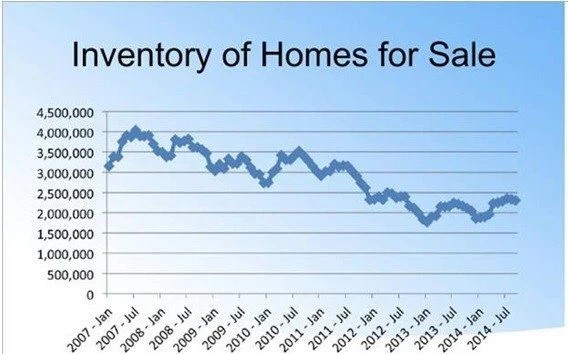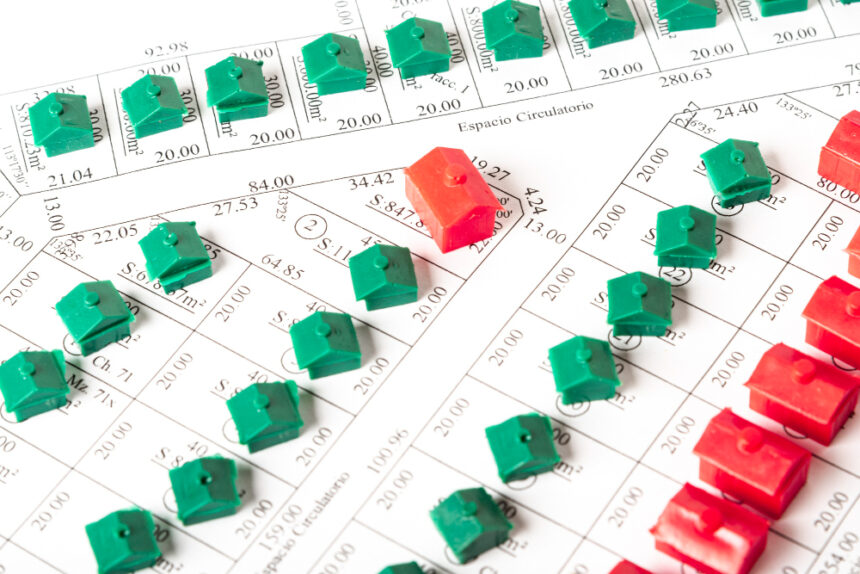After months of sluggish activity, the housing market is finally showing signs of life. A surge in housing inventory is giving buyers more options, and the result is an increase in home sales. While the market had been characterized by a lack of available properties, high mortgage rates, and buyer uncertainty, the recent shift in inventory levels is helping breathe new energy into residential real estate.
This blog post dives deep into the latest trends, explores why inventory matters, and breaks down how more options for buyers are creating positive momentum in the real estate market. Whether you’re a buyer, seller, or investor, understanding the current state of home sales is crucial to making informed decisions in today’s housing landscape.
The Housing Market Was Stuck in Neutral
Over the past year, home sales across the country have been stagnant. Several key factors contributed to this pause:
- Rising interest rates: As the Federal Reserve increased rates to combat inflation, mortgage rates soared, pushing many would-be buyers out of the market.
- Low inventory: Sellers were reluctant to list their homes, especially those locked into ultra-low mortgage rates from previous years.
- High prices: With fewer homes on the market, competition drove prices higher, making affordability a challenge.
This cocktail of conditions created a bottleneck, with both buyers and sellers sitting on the sidelines. As a result, home sales plummeted in many regions, and real estate professionals braced for a long slowdown.
What Changed? Inventory Begins to Climb
In early 2025, data began showing a modest but noticeable increase in the number of homes hitting the market. By March, housing inventory was up in many major metro areas, and more listings meant more choices for buyers.
Why Inventory Matters
Inventory is one of the most critical metrics in the housing market. When inventory is tight:
- Buyers face bidding wars.
- Prices climb quickly.
- Many potential buyers get priced out or give up entirely.
But when inventory grows:
- Buyers have more negotiating power.
- Price growth stabilizes or slows down.
- Homes stay on the market longer, giving buyers time to make decisions.
This balance of supply and demand plays a massive role in the pace of home sales. With inventory finally on the rise, buyers are re-engaging, and sales numbers are starting to rebound.
Real Estate Agents Report a Pickup in Activity
Across the country, real estate agents are seeing increased activity at open houses and more inquiries from serious buyers. Homes that might have languished on the market just a few months ago are now attracting multiple offers—albeit more measured than the frenzies of 2021 or 2022.
In hot markets like Austin, Phoenix, and Tampa, home sales are picking up as new listings offer fresh opportunities for first-time buyers, upgraders, and investors alike.
Factors Behind the Inventory Rebound
The increase in housing inventory isn’t accidental. Several trends are converging to boost the number of homes for sale:
1. Sellers Regaining Confidence
Many homeowners who had delayed listing their properties due to uncertainty are now feeling more optimistic. They’re betting that spring 2025 will offer better conditions, and they’re listing accordingly.
2. New Construction Additions
Homebuilders have ramped up construction after years of underbuilding. With materials costs stabilizing and labor markets loosening slightly, more new homes are coming online, especially in suburban and rural areas.
3. Investor Offloads
Some real estate investors are unloading properties as rental profits shrink and property taxes rise. This is adding more inventory, particularly in the starter home category.
4. Relocation Trends
As remote work becomes more permanent, people are making big lifestyle changes—moving to more affordable cities or back to their hometowns. These moves are leading to more listings in traditional job hubs like San Francisco, New York, and Chicago.
A Buyer’s Market? Not Quite—But There’s Balance

Even with the recent increase in inventory, the housing market hasn’t completely shifted in favor of buyers. It’s more accurate to say that the market is becoming more balanced.
Home sales are growing, but prices remain elevated compared to pre-pandemic levels. Sellers still hold some leverage, especially in desirable areas with strong school districts, low crime, and good walkability.
However, buyers are gaining some breathing room:
- Fewer bidding wars than in recent years.
- More price reductions on stale listings.
- Negotiating room on repairs, closing costs, and contingencies.
This shift toward equilibrium is healthy for the market and encourages sustainable home sales growth over time.
Regional Spotlight: Where Home Sales Are Surging
Let’s look at a few cities where the housing inventory boost is directly translating into more robust home sales:
1. Raleigh, North Carolina
With strong job growth and a booming tech sector, Raleigh is attracting new residents in droves. New housing developments and condo conversions are keeping inventory levels healthy, driving up home sales numbers.
2. Denver, Colorado
After a steep slowdown in late 2023, Denver is seeing a rebound in listings and transactions. Buyers are back in the game, especially younger professionals drawn to the city’s outdoorsy lifestyle and growing job market.
3. Nashville, Tennessee
Nashville has seen a consistent uptick in home sales thanks to new construction and a steady inflow of newcomers. Suburbs like Franklin and Murfreesboro are particularly active.
4. San Diego, California
While inventory remains below historical norms, the slight increase this spring has led to more closed sales, especially in the $500,000 to $900,000 price range. Sellers are more willing to negotiate, and buyers are responding.
Mortgage Rates: Still High, But Stabilizing
One of the key factors shaping the current market is mortgage interest rates. While rates remain significantly higher than during the pandemic-era lows, they have stopped climbing—bringing some much-needed predictability to the market.
According to Freddie Mac, the average 30-year fixed mortgage rate as of March 2025 is hovering around 6.5%—down from a peak of nearly 8% in 2023.
Lower rate volatility helps homebuyers plan with more confidence. Many are opting for:
- Adjustable-rate mortgages (ARMs) for short-term affordability.
- Rate buydowns offered by builders or sellers.
- Mortgage points to lock in slightly lower rates.
This improved predictability is helping convert home shopping into actual home sales.
First-Time Buyers Return to the Market
The return of inventory is especially welcome news for first-time homebuyers. These buyers were often the most impacted by the previous inventory crunch and rising rates.
Now, with more homes available in the $250,000 to $400,000 range, many first-time buyers are finding options that suit their needs and budgets. Some are also taking advantage of down payment assistance programs and FHA loans to help close the gap.
This growing segment is crucial to sustaining healthy home sales figures, as they drive demand from the bottom of the market upward.
What This Means for Sellers
Sellers should view the current moment as a window of opportunity. With more buyers actively searching—and less fear of sudden interest rate spikes—well-priced homes can still sell quickly.
However, sellers must be realistic:
- Overpriced homes are sitting longer.
- Staging and marketing matter more.
- Buyers expect value and are comparing more options.
Homes that are turnkey, priced appropriately, and located in desirable neighborhoods are seeing the fastest turnaround and generating the most interest.
Real Estate Professionals Must Adapt
Agents, brokers, and lenders are finding this environment more dynamic—and potentially more profitable—than the stagnant market of the past year.
With more listings and active buyers, transaction volumes are climbing. Still, professionals need to stay ahead of changing buyer behaviors and local trends to succeed.
Tactics that are working in 2025 include:
- Targeted digital marketing to showcase listings.
- Virtual tours and 3D walkthroughs for remote buyers.
- Flexible showing schedules and weekend open houses.
The Outlook: What’s Next for Home Sales?
Most economists agree that if current trends continue, home sales will see modest but steady growth through the rest of 2025.
Key indicators to watch include:
- Interest rates: Will they stay stable or begin to fall?
- New construction: Can builders maintain output?
- Buyer sentiment: Will affordability concerns rise again?
The likely scenario is a more balanced housing market, with supply catching up to demand and home sales gradually returning to normal seasonal patterns.
Tips for Buyers in Today’s Market
If you’re considering buying a home in 2025, here are some strategies to help you make the most of the current market:
- Get pre-approved early: Know your budget before shopping.
- Work with a local agent: They can help you navigate neighborhood trends.
- Be ready to act: Good homes are still selling quickly.
- Consider homes that need cosmetic updates: They may offer better value.
- Don’t overextend your budget: Stick to what you can afford, even if you qualify for more.
Tips for Sellers in Today’s Market
And if you’re thinking of selling, here’s how to position your property effectively:
- Price it right: Don’t chase unrealistic numbers.
- Stage your home: First impressions still matter.
- Be flexible: Accommodate showings and consider buyer concessions.
- Highlight unique features: From energy-efficient appliances to smart home tech.
- Work with a knowledgeable agent: Marketing matters more than ever.
Home Sales See Hope After a Quiet Stretch
After months of stagnation, the housing market is finally beginning to show signs of recovery. The increase in housing inventory is creating more opportunities for buyers and helping boost home sales figures across many regions.
While challenges like affordability and mortgage rates remain, the renewed energy in the market is a positive sign for anyone involved in real estate. Buyers are re-entering the market, sellers are listing more confidently, and real estate professionals are adjusting to a healthier, more balanced landscape.
For now, the takeaway is clear: More choices mean more movement—and more movement means better prospects for everyone in the housing ecosystem.

